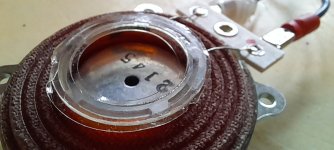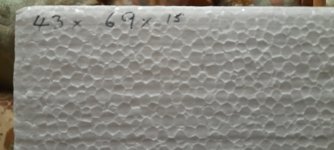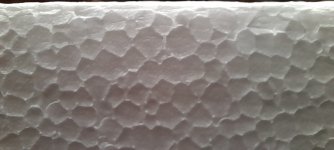Forrest Gump tired !looks like that former might be a bit tired?
Those are sweet! A pair of these with an oval face would be cool, or a fat figure eight.Here's a pic of an open baffle Alpha15a similar to the one I built with my partner a while ago.
I've done exactly this. Two panels left, two panels right, different size panels, same material and exciters. Needed 8ohms so did this in series and to just see what it sounded like. Definitely a larger sound field. The individual pairs were spaced side by side with about 7' between pairs.your comment about four close exciters makes me wonder about multiple single exciter panels. if one were to use say four panels (two per channel) does anybody have any experience with doing this? if so do the two panels per channel present a larger sound field if spaced closely or wider apart? Thanks.
My entire surround system is DML and listening to 5.1 recorded concerts is amazing! Pink Floyd "The Wall" movie.... WOW!thanks very much for your input I would expect that room acoustics will play a major factor in using multiple panels per channel especially so if the panels are space apart.
At a guess I would expect a pair of small panels in front of you to the left and right similar to a conventional stereo set up along with a second set of stereo small panels set up farther away from you (to increase arrival time from the front pair of panels)
with some tweaking in the set up I would expect a larger perceived sound field than with a single pair of small DNL panels, especially if the second set of panels can be situated to the back side or to the rear of the seating position. This is however mere speculation on my behalf at this time.
I was thinking more along the lines of time delay for a secondary pair of panels which could be achieved by placing the second pair behind and farther away from the listening position or the second pair of panels could be in front of the listening position and they you could play pool with them by directing them such that several wall bounces (the longer the better) delivers their output to the listening position and again preferably arriving from behind the listening position. Even though the panels radiation is so diffused the late arrival time when compared to the front main panels should generate a sense of a large ambient space.Moray I think you might find that room acoustics have less effect on DML panels than with pistonic speakers. Weirdly, DMLs don't seem to activate the resonant modes as much as cones do.
This is all probably to do with the diffuse wave front that they produce, DMLs do not produce a solid wave front across the spectrum. Visualise a pebble vs a handful of fine sand dropping into a pond (credit to whomever it was that used this image before on the forum.)
DMLs are omni-directional. You'll battle directing them anywhere. But if you are keen on directing them, then you might have to resort to baffle panels variously placed between the secondary pairs and your listening position so that the direct sound is absorbed and not as loud as the reflected sound.by directing them such that several wall bounces (the longer the better) delivers their output to the listening position and again preferably arriving from behind the listening position.
Your secondary (delayed?) panels will also smear the transients on your primary panels because the SPL fall-off over distance is not as great as with boxes/cones. Minimise this by using a separate amp with a separate level control that you might have to turn down a bit. But it might still sound a bit weird. Roll off the top and the bass end of the secondary panels to minimise the inevitable chorus effect you might get otherwise.
a second pair situated next to the floor in the back corners of the room (to the left and right of the seating position) some absorption panels could be used close to those exciter panels. If the floor is carpeted all the better. This would place the second set of speakers in a position to excite the long room diagonal resonances which are the longest in the room and would provide the longest delay (reflection time). I wonder what that might sound like.
Having never played with panels like these I am just thinking out loud here. Is it reasonable to think that with a single pair of exciter panels in a stereo set up they will provide a better balanced image and sound stage if they are symmetrically placed within the room? so this would be an equilateral triangle set up with your head at one point and a speaker panel at the other two points further having equal distance to the left and right wall from each speaker. Does symmetry like this have any impact upon the balance of the stage and image? this is so different from setting up conventional loudspeakers. the closest I have cone was with a pair of electrostatic speakers which were quasi omni-directional. They seemed to appreciate a symmetrical set up. that was a very long time ago and I did not get much time to experiment with them.
Having never played with panels like these I am just thinking out loud here. Is it reasonable to think that with a single pair of exciter panels in a stereo set up they will provide a better balanced image and sound stage if they are symmetrically placed within the room? so this would be an equilateral triangle set up with your head at one point and a speaker panel at the other two points further having equal distance to the left and right wall from each speaker. Does symmetry like this have any impact upon the balance of the stage and image? this is so different from setting up conventional loudspeakers. the closest I have cone was with a pair of electrostatic speakers which were quasi omni-directional. They seemed to appreciate a symmetrical set up. that was a very long time ago and I did not get much time to experiment with them.
do you recall what kind of wood you used as an interface between the exciter and the panel? Spedge has used balsa wood ply and also a harder thin plywood but he does not know what type of wood it was.."- adding a 1/16" wood panel between the xps and exciters gets rid of almost all of the hollow sound but still doesn't have great transient response. More efficient than the plywood panel but obviously quieter than xps alone."
+ @moray jamesDon't stereo cartridges read both horizontal and vertical in a 45degree alignment?
From : https://www.leson.org/understand-phono-cartridges-reference-paper/. A page picked from the wiki page "phono cartridge"
Vertical => L = R
Just your run of the mill thin 3 layer ply from The Home Depot. I would like some proper luthier panels... not paying that much.do you recall what kind of wood you used as an interface between the exciter and the panel? Spedge has used balsa wood ply and also a harder thin plywood but he does not know what type of wood it was.
Thanks for the coating tips Leob, I made a couple of panels in a similar style to yours with the front and back of the panel supported in 6 places with closed cell foam. I uses Hide glue and Shellec as suggested and wow they are the best I've made/heard. Only one exciter each at present but the frequency response is so much smoother and highs much better than my previous PVA coating. I am using a HD EPS 500/320mm in size. The Exciter is a dayton 25fhe at the 3/5 2/5 location.
At first I measured and there was a steep drop off from 300HZ down but lots of highs. I gave them a sand front and back and now measure nicely down to 100HZ ish before they drop off. I must have coated with too much Shellac and they were too stiff.
This is in room away from walls and floor no EQ and 1/6 smoothing. Pretty happy with the results and sound.

At first I measured and there was a steep drop off from 300HZ down but lots of highs. I gave them a sand front and back and now measure nicely down to 100HZ ish before they drop off. I must have coated with too much Shellac and they were too stiff.
This is in room away from walls and floor no EQ and 1/6 smoothing. Pretty happy with the results and sound.
Hello MorayJames,do you recall what kind of wood you used as an interface between the exciter and the panel? Spedge has used balsa wood ply and also a harder thin plywood but he does not know what type of wood it was.
There are somewhere posts between Steve and I about "balsa wood" to make a pad for a canvas panel. We came to the conclusion that what is sold under "balsa wood" naming is in fact not balsa but most probably in my opinion basswood. I built my panels before understanding that so I made the pad of my canvas panels with 2 layers of 1mm balsa board. It works but I cant tell the difference with the orginal plywood targeted.
Christian
Hello Joska,At first I measured and there was a steep drop off from 300HZ down but lots of highs. I gave them a sand front and back and now measure nicely down to 100HZ ish before they drop off. I must have coated with too much Shellac and they were too stiff.
Nice FR!
Could you tell us a bit more about your panels (sorry if it is in posts before, for now I check time to time this thread...)?
- do you know more precisely the EPS density?
- from which thickness do you start (300Hz version) and what is the final one (100Hz version) ?
- you mention a suspension in 6 points. Could you remind their locations? This might be in Loeb's posts but you know how it is easy to go back to information in this thread.
- how the exciter is glued to the panel (original 3M, PVA, epoxy, other...)?
Christian
That's almost 130db in total on the Y axis......This is in room away from walls and floor no EQ and 1/6 smoothing. Pretty happy with the results and sound.
View attachment 1290818
Show us what it looks like from 60db to 120db?
The exciter fell off of the round fluted proplex.
The picture shows the soft mounting tape, with its overhang on both sides, which i was not happy about.
You can see the tape sagging.
so I have decided to use this on a small thin wood panel I have been waiting to try.
I think I might compare this to a BMR my friend has lent me(only about a year ago ,🙄 better late than never) only if it measures OK, that is ?
I am not yet going to try the new eps , but here are a couple of pictures of the surface of the material and size in cm.
Steve.
The picture shows the soft mounting tape, with its overhang on both sides, which i was not happy about.
You can see the tape sagging.
so I have decided to use this on a small thin wood panel I have been waiting to try.
I think I might compare this to a BMR my friend has lent me(only about a year ago ,🙄 better late than never) only if it measures OK, that is ?
I am not yet going to try the new eps , but here are a couple of pictures of the surface of the material and size in cm.
Steve.
Attachments
could you share what the actual density is of the EPS foam that you are using please?I am using a HD EPS 500/320mm in size.
Hello Steve there is quite a difference in the density of those two samples judging by the size of the ball size of the foam as seen in your two photos. The first sample shown looks to be about three times as dense as the second sample. Does this visual assessment match up with a physical evaluation? The smaller the degree of expansion the higher the density.
- Home
- Loudspeakers
- Full Range
- A Study of DMLs as a Full Range Speaker


